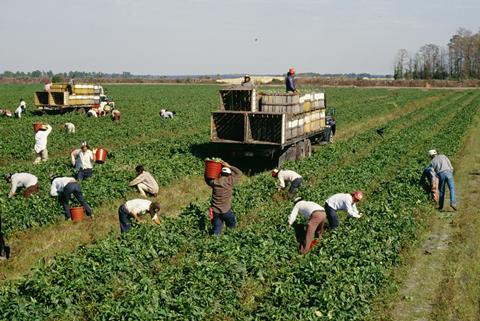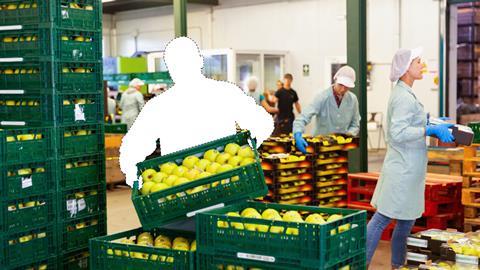Younger generations don’t view food and drink as a desirable industry to work in. With an ageing workforce, and post-Brexit red tape pushing away foreign staff, how can it become attractive once more?
Today is a landmark moment, as we come together to launch Mmmake Your Mark and celebrate what makes our industry an incredible place to work.” So went the launch script for the IGD’s big push to tackle the food and drink sector’s recruitment crisis last month.
First revealed in the pages of The Grocer, its arrival was marked by a co-ordinated set of endorsements from major suppliers and retailers. Senior leaders at the likes of CCEP, Greencore and Co-op all voiced their support on social platforms, and shared the IGD’s colourful set of complementary assets with their thousands of followers.
“We started with what we hoped would be a thunderclap moment,” says the IGD’s social impact director Naomi Kissman. “I think anyone working in the industry on LinkedIn that week would have found it pretty difficult to miss, which was the intention.
“I believe we had over 40 of the biggest businesses giving commitments from their comms teams to do something at the start. What we hoped is that it would encourage more companies to do the same, and we’d start to see a ripple effect.”
The IGD’s ambition isn’t to go viral, though. It’s much bigger than that. With its latest effort to get people talking about the opportunities within food and drink, the IGD – and its backers – hope the ‘Mmmake your Mark’ campaign can start a sorely needed conversation around how the sector can start to tackle one of its biggest challenges: recruitment.

So, beyond a splashy social presence, how exactly does the campaign plan to do that? Is it the right approach? And what exactly is the scale of the challenge it faces in helping the industry plug its talent gaps?
The impetus for the campaign came from the results of the Independent Review into Labour Shortages in the Food Supply Chain. The enquiry, made up of an expert industry panel, delved into the gamut of workforce challenges the sector faces and published its findings and recommendations in June 2023. Top of the list: implement a comprehensive strategy to enhance the sector’s attractiveness.
“People would ask us: why can’t you be more like the army in terms of the impact of their recruitment campaign? But we’re not the army”
Naomi Kissman, IGD
And so, invited to co-chair the workforce and skills committee set up to respond to the panel’s recommendations, the IGD made that its starting point. “The premise of this has been to take those recommendations and say: ‘right, how do we act in collaboration as an industry across businesses, government and trade bodies [to action them]?’” says Fiona Miller, IGD’s director of people programmes. “We took that first recommendation around sector attractiveness and raising the profile of careers in food as the focus at the outset.”
It was a logical step given both the IGD’s decades of experience going into schools and colleges in an effort to talk up the industry, and yet still how worryingly few young people have food and drink on their radar. Almost half (49%) of 16 to 24-year-olds say they haven’t even considered it, according to research by Censuswide on behalf of IGD. Many weren’t even aware certain roles existed in the industry, including software engineer (51%), data scientist (41%), technologist (41%) and biochemist (36%).
Impact on productivity
The productivity of the food chain in 2020 decreased by 1.5% vs 1.1% in the wider economy
Over the 10 years to 2020, the average annual growth rate of the food chain was only 0.1% vs 0.2% in the wider economy
Source: Defra
“I remember sitting in one of our meetings earlier this year, talking about this campaign, and we heard from one food manufacturer who said the employer of choice in his region for engineers is Siemens, and yet his organisation employs about 10 times the number of engineers they do,” says Kissman. “But people don’t see that, they don’t recognise it or understand it.”
The campaign is designed to build awareness and reframe perceptions of the types of jobs and opportunities available in the industry, and the skills required. There are aspirational profiles of existing employees, eye-catching stats and content that makes clear the connection between the sector and a purposeful career (which 81% of 16 to 25-year-olds say they want, according to Samsung research), mapping out the chance to impact sustainability, nutrition and health.
The hope is that industry employers, trade bodies and other organisations will use the toolkit of free-to-use assets, including graphics, videos and presentation templates, to share the ethos and messaging of the campaign via their own social channels, events and even recruitment platforms.
“There’s a tendency in the industry to make cost-focused decisions when trying to recruit talent”
Emilie Gregson, Signature Career Management
There are also plans to work further with schools and collaborate with the Department of Work & Pensions to access harder-to-reach talent pools, such as spreading the word via job centres.
Even so, it’s hard not to conclude that the success or failure of the campaign will rest heavily on the willingness and appetite of key industry players to make the effort and get involved.

In part, that’s the idea. “People would ask us the question: why can’t you be more like the army in terms of the impact of their recruitment campaign?” says Kissman. “But we’re not the army – we’re not sitting there as one organisation with a big advertising budget behind it. We recognised quite quickly that the question was: how do we mobilise the army of the food industry? The delivery plan shows that it involves collaboration across the whole supply chain.”
A good start
There are some positive early signs of engagement. “We’re getting more and more enquiries about getting involved and what that could look like,” Kissman says.
But is it enough? It’s a good start, say experts.
“I am encouraged by the support the campaign has had from the major food and grocery businesses,” says John Shropshire, chairman of G’s Fresh Group and chair of last year’s independent review panel. “The campaign has some strong themes that can be developed as the campaign evolves. It’s still early days and we need to see the continuation of industry co-operation to continue to shine a light on the great career opportunities that exist in our industry.”
There’s no doubt getting the word out and challenging misconceptions among core groups, such as university graduates, needs to happen, adds Steve Simmance, founder and MD of recruitment firm The Simmance Partnership. “I’ve been banging this drum for 30 years,” he says. “Back in the day, the university milk rounds were prolific, with fmcg employers extolling the virtues of why the industry was such a great place to work. Today, I don’t believe, talking to undergraduates or recent graduates, we are getting anywhere near the same reception or calling from fmcg employers on rounds at universities or schools.”
“It has to just be a start, though,” says Simon Walton, who leads the consumer practice at Berwick Partners. “It has to be an ongoing conversation and a concerted effort, perhaps with other campaigns to follow this. We need to get together the great and the good, whether it be the FDF, IGD, or The Grocer, and it has to be a long-term campaign. It can’t be seen as a panacea, or that ‘we’ll do this and it’ll solve all the issues’,” he adds.

After all, let’s face it, those issues are pretty complex and extensive.
Defra figures show that, though the number of people employed in the agri-food supply chain increased by 11% – or 400,000 workers – in the past 20 years (2000-2021), that growth is largely down to roles in catering (+38%). In agriculture and manufacturing, by contrast, there was a significant decline in employment during that period of 23% and 11% respectively. Wholesale (+4%) and retail (+9%) fared slightly better.
“We need to get together the great and the good, and it has to be a long-term campaign. It can’t be seen as a panacea”
Simon Walton, Berwick Partners
Where staff numbers have shrunk, that doesn’t reflect an industry that’s suddenly worked out how to do more with fewer people either. In Q2 this year, vacancy rates in food and drink manufacturing roles were 4.9%, nearly double that in wider manufacturing (2.6%), according to the FDF’s State of Industry survey. Just under half of manufacturers (45%) reported vacancies of up to 5%, with SMEs suffering more (6.4%) than large businesses (3.8%). Overall, the FDF estimates the cost to the industry of this shortfall was about £1bn in lost output in 2023.
There are some particular weak spots. Simmance flags a lack of “capable, ambitious sales talent coming through the ranks”, in particular those willing and able to take on national account manager roles. There were also some 6,000 fewer delivery and courier drivers in the UK in 2023 versus the previous year, say the ONS, with over half (55%) of existing HGV drivers aged 50 to 64 and heading towards retirement in the next decade.
The UK’s missing workforce in numbers
4 million
The number of people working in UK grocery, making it the largest private sector employer
Source: IGD Viewpoint
680,000
The number of people employed by the ‘big four’ grocers alone
Source: Tesco, Sainsbury’s, Asda, Morrisons
21.9%
The UK economic inactivity rate from May to July 2024 – fuelled in part by long-term illness and early retirement levels [ONS]
Source: ONS
But this isn’t a problem limited to any single role or function, insists Emilie Gregson, director at fmcg specialist recruiter Signature Career Management. “Labour challenges within fmcg are an industry-wide issue that are effecting all levels of expertise, ranging from high-skilled roles such as engineering, technical roles such as NPD, and lower-level roles such as warehouse operatives,” she says. “The challenging thing for the industry is that there’s a perfect storm of pressures. Unfortunately, none of these challenges have a quick fix.
“Brexit and Covid caused many of the lower-skilled workers to leave the UK, and further to this, Covid decimated certain channels such as out of home and hospitality, with many workers seeking employment in other industries and then not returning,” she adds. “There is also an ageing workforce, meaning the rate at which skilled workers are leaving the industry is increasing. Couple this with the rapid shift to remote teams, and there isn’t the level of knowledge share and collaboration between older and newer workers to enable the skills gap to be bridged as effectively.”
The food and drink sector isn’t struggling alone, of course. “The backdrop here is that, overall, we’ve got a talent shortage,” says Walton. “And that’s not food and drink-related and that’s not fmcg-related.”
The latest ONS data shows economic inactivity in the UK remains high (21.9%), making it the only G7 country whose employment rate is not back to pre-pandemic levels. That’s fuelled by a record high in those registered as long-term sick, who now make up 7% of the working-age population, and a post-Covid uptick in early retirement, with some 5.3 million UK workers over 50 considering such a move as of the end of 2023, according to research by tech start-up Multiverse.
“Brexit and Covid caused many of the lower-skilled workers to leave the UK”
Emilie Gregson, Signature Career Management
Multifaceted, multi-layered and, frankly, a bit of a minefield, it’s a problem for which multiple solutions will be required, rather than a single campaign. It’s why the members behind the Independent Review into Labour Shortages in the Food Supply Chain mapped out nine more recommendations in last year’s report. These included improving access to migrant labour, calling on employers to offer greater training and career development opportunities and reviews of the Apprenticeship Levy and food-related school curriculum.
There have already been some positive steps taken in response. The seasonal worker scheme (SWS) was extended in May until at least 2029. The government also says it has plans to replace the existing Apprenticeship Levy with a new Growth & Skills Levy that it insists will provide far greater flexibility.
“We’re still in the early days of the new government, and we have heard positive noises from them with regards to the Defra key priority to boost food security, and ensure the British food and farming sectors thrive,” says Shropshire.

“In the coming weeks we need to see the detail of the Labour government’s food and agriculture priorities, as this will give businesses the confidence to invest. We must have the right long-term access to seasonal labour as we develop automation capability while at the same time building the skills and talent pipeline that will allow the sector to grow.”
It can’t only be left to the government either. Industry HR teams need to make changes too, believes Gregson. “There’s a tendency in the industry to make cost-focused decisions when trying to recruit talent, especially given how overheads have been increasing over recent years.” This narrows talent pools, she says, with employers fighting for the same people. By taking a more holistic approach and “providing opportunity to diversify talent pools, this will deliver long-term sustainable growth in the workforce”.
As will, of course, getting out there and spreading the word about what makes food and drink a great place to work. It just can’t be the whole conversation.
Three aggravating factors in fmcg’s recruitment crisis
An ageing workforce
Supply chains were brought to a virtual halt in 2021 when a shortage of HGV drivers led to major delays and months-long repercussions. And though a Covid-induced spike in online orders was partly to blame, the high average age of drivers – coupled with poor pay and worsening conditions – had seen many take early retirement, without enough qualified drivers to fill the gaps.
That dynamic isn’t limited to logistics either. It’s estimated a third (32%) of farm workers are aged 55-64 (while only 11% are aged 16-24) and over 40% of workers in food processing are over the age of 45. The FDF has estimated a third of the current workforce will have retired by 2033, a trajectory accelerated by the swathe of workers that opted for early retirement during Covid.

An image problem
When young people were asked by educational consultants Uptree what sectors they most wanted to work in, they listed business and finance (47%); STEM (42%); law (31%); marketing and media (22%); pharmaceuticals (9%) and insurance (8%). Food and drink – despite being the UK’s biggest private sector employer – didn’t even get a mention. That tallies with the latest IGD research, which found half of 16 to 24-year-olds hadn’t even given it a second thought.
Coupled with an ageing workforce, the sector is facing an unwieldy, top-heavy dynamic that urgently needs addressing. Alongside campaigns such as the IGD’s, members from last year’s independent review recommended reviewing the curriculum, improving pay and conditions, and greater flexibility from employers.
Loss of migrant labour
In 2016, a report by AHDB calculated that 20% of the permanent workforce in agriculture and horticulture, plus 40% in food manufacturing, was made up of EU nationals. Even ahead of the formal exit from the EU, thousands decided to leave the UK, and there has been a steady reduction in migrants taking on these roles in the food supply chain ever since, amplified by the decision by many more to leave during the pandemic.
The introduction of the seasonal worker scheme and its recent extension to 2029 has gone some way to addressing this, but there have still been steady year-on-year declines– with circa 38,000 EU workers within agriculture as of 2019, versus circa 25,000 in 2023, according to a government review that was published in July.




















No comments yet